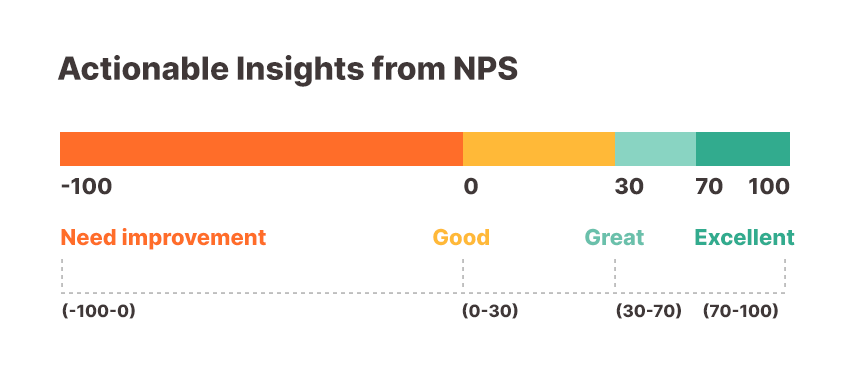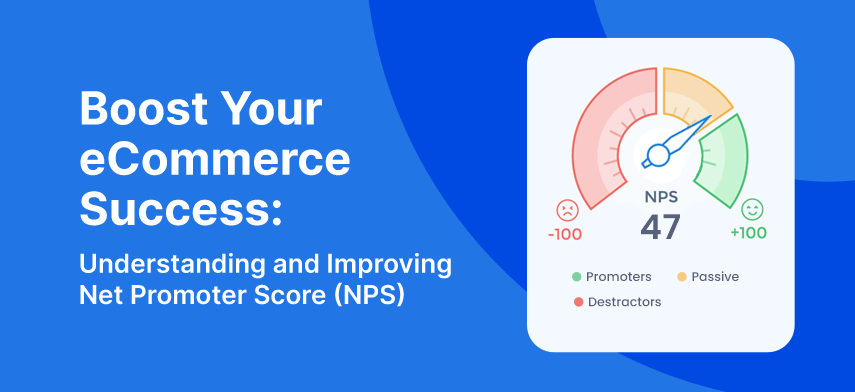Net Promoter Score (NPS) is a key performance indicator (KPI) used by eCommerce companies to measure customer satisfaction and loyalty. It is calculated based on customer responses to a single question: “On a scale of 0 to 10, how likely are you to recommend our product/service to a friend or colleague?”
How NPS is Calculated

1. Classification of Respondents:

- Promoters (score 9-10): Loyal customers who are likely to recommend your company.
- Passives (score 7-8): Satisfied but unenthusiastic customers who are vulnerable to competitive offerings.
- Detractors (score 0-6): Unhappy customers who can damage your brand through negative word-of-mouth.
2. NPS Calculation:
- NPS = [%of Promoters] - [% of Detractors]
Importance of Net Promoter Score in eCommerce

- Customer Loyalty: Higher NPS indicates strong customer loyalty, which is critical for repeat purchases and long-term revenue.
- Customer Feedback: Helps identify areas for improvement by understanding customer sentiments.
- Benchmarking: Allows comparison with industry standards or competitors to gauge relative performance.
Actionable Insights from NPS

1. High NPS (50+):
- Strength: Indicates strong customer loyalty and satisfaction.
- Action: Continue to maintain high standards and leverage promoters for referrals and testimonials.
2. Moderate NPS (0-50):
- Strength: Shows a balanced customer base but room for improvement.
- Action: Identify areas for improvement by analyzing feedback from passives and detractors. Focus on converting passives to promoters.
3. Low NPS (<0):
- Strength: Indicates significant customer dissatisfaction.
- Action: Immediate investigation and action are needed to address customer concerns. Engage with detractors to understand their issues and find solutions to improve their experience.

Utilizing NPS Feedback
- Categorize Feedback: Divide feedback into themes (e.g., product quality, customer service, delivery) to identify common issues.
- Prioritize Actions: Focus on high-impact areas that can turn detractors into promoters.
- Monitor Trends: Regularly track NPS over time to see the impact of changes and improvements.
Example of NPS Interpretation
If an eCommerce company has an NPS of 45, it means they have a healthy balance of promoters over detractors, indicating good customer satisfaction but also highlighting areas for potential improvement. They should analyze feedback to understand what promoters love and what detractors dislike, and then take targeted actions to enhance customer experiences.
A successful eCommerce company with a high NPS typically demonstrates:
- Efficient delivery and return processes.
- High product quality and variety.
- Excellent customer service.
- A user-friendly website or app interface.
Industry Benchmark
The average NPS varies significantly across industries. For eCommerce, a good NPS can range from 30 to 50, with top-performing companies achieving scores above 50. It's important to note that these benchmarks can fluctuate based on various factors like market conditions and customer expectations.
Improving NPS in eCommerce
Improving Net Promoter Score (NPS) for eCommerce involves a multifaceted approach focused on enhancing customer experience, satisfaction, and loyalty. Here are detailed techniques to help eCommerce businesses improve their NPS:
1. Enhance Customer Service
- 24/7 Support: Offer round-the-clock customer support via live chat, email, and phone to address customer issues promptly.
- Training Staff: Ensure customer service representatives are well-trained, empathetic, and empowered to resolve issues effectively.
- Multi-channel Support: Provide support through multiple channels, including social media, which allows customers to reach out in their preferred manner.
2. Improve Product Quality and Variety
- Quality Assurance: Implement stringent quality control processes to ensure products meet high standards.
- Product Feedback Loop: Collect feedback on products regularly and use it to make improvements or expand product lines.
3. Optimize Website and Mobile Experience
- User-Friendly Design: Ensure your website and mobile app are easy to navigate, with clear calls to action.
- Loading Speed: Optimize loading times to reduce bounce rates and improve user experience.
- Mobile Optimization: Make sure the mobile shopping experience is as seamless as on desktop, as more customers shop on mobile devices.
4. Streamline the Checkout Process
- Simplify Checkout: Reduce the number of steps in the checkout process and allow guest checkouts to make purchasing quick and easy.
- Multiple Payment Options: Offer various payment methods to cater to different customer preferences.
- Clear Return Policy: Provide a transparent and hassle-free return policy to build trust with customers.
5. Personalize Customer Experience
- Personalized Recommendations: Use customer data to provide personalized product recommendations and offers.
- Email Marketing: Send personalized emails with relevant content, offers, and updates to keep customers engaged.
6. Gather and Act on Customer Feedback
- Surveys and Polls: Regularly send out surveys and polls to understand customer preferences and pain points.
- NPS Follow-ups: Reach out to detractors to understand their issues and work on resolving them. Similarly, engage with promoters to encourage referrals and testimonials.
7. Loyalty Programs and Incentives
- Rewards Programs: Implement loyalty programs that reward repeat customers with discounts, points, or exclusive access.
- Referral Incentives: Encourage existing customers to refer new customers by offering incentives such as discounts or freebies.
8. Transparency and Communication
- Order Tracking: Provide real-time tracking information for orders.
- Regular Updates: Keep customers informed about their order status and any potential delays.
- Transparency in Pricing: Ensure pricing is clear and transparent, including shipping costs and any additional fees.
9. Engage with Customers on Social Media
- Active Social Presence: Engage with customers on social media platforms, responding to their queries and feedback promptly.
- Social Listening: Use social listening tools to monitor and respond to customer sentiment and feedback in real-time.
10. Implement a Strong Post-Purchase Experience
- Follow-Up Emails: Send follow-up emails to ask for feedback and offer support.
- Content Marketing: Provide valuable content related to their purchase, such as how-to guides or tips.
By implementing these strategies, eCommerce companies can significantly enhance their customer satisfaction and loyalty, leading to an improved Net Promoter Score (NPS).

Conclusion
Net Promoter Score (NPS) is a powerful metric for eCommerce companies, providing deep insights into customer satisfaction and loyalty. By asking customers how likely they are to recommend a product or service to others, businesses can classify respondents into promoters, passives, and detractors. This simple yet effective scoring system, ranging from -100 to +100, helps companies understand their overall customer sentiment.
Interpreting NPS involves recognizing the balance between promoters and detractors and comparing the score against industry benchmarks to gauge performance. An NPS above 0 is generally positive, while scores above 50 indicate excellent customer loyalty, and scores above 70 are considered world-class. Regularly tracking and interpreting NPS helps businesses identify trends and areas needing improvement.
We also looked at various techniques you can implement to improve the Net Promoter Score. So are you ready to take your customer satisfaction to the next level? Contact us to learn more on how you can improve your eCommerce website and mobile apps to achieve a top NPS!





 May 24, 2024
May 24, 2024


